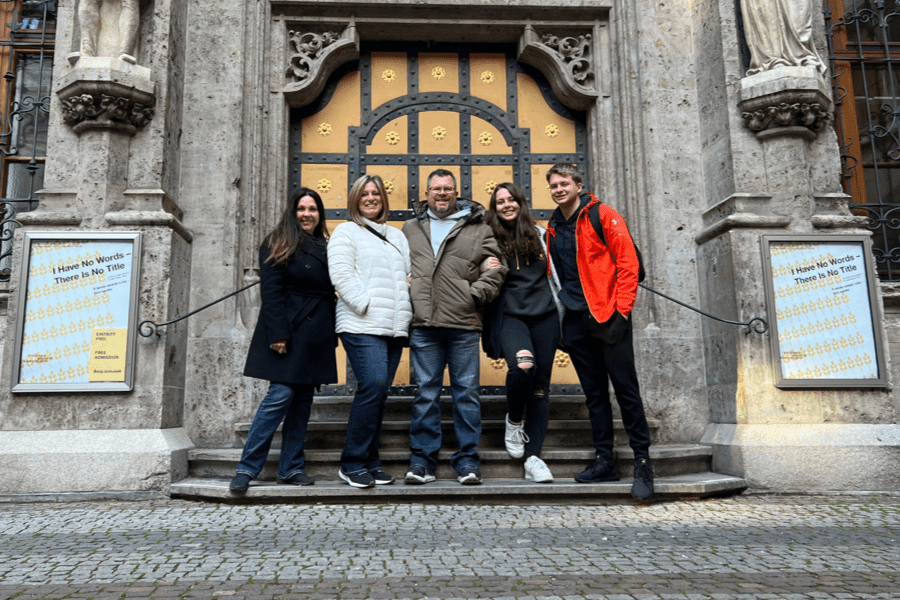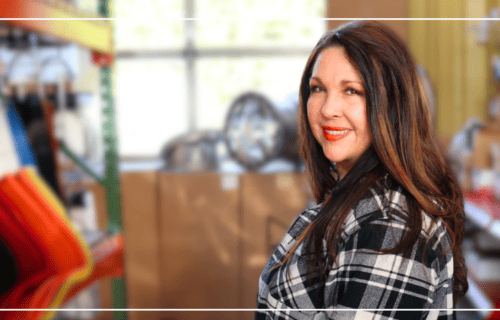
10 Days in Europe | Germany to Czechia to Belgium
It has been my lifelong dream to travel to Europe. Currently, my niece is studying architecture in Prague, so I had a chance to join my brother, his wife, and my nephew on the journey.
There‘s a lot of Europe to see and we didn‘t have a whole lot of time. Therefore, we focused on areas that represented our ancestry. A large portion of our genealogy tracks to the Bavarian portion of Germany. The rest is from Belgium or Luxembourg.
We flew into Frankfurt, Germany, drove to our German destinations until we reached Munich, took a train to Prague, flew to Brussels, Belgium, drove to Bruges, and then flew home from Brussels.
Day 1 – Frankfurt – Würzburg – Rothenburg
We arrived at the Frankfurt airport at around 10 am. After renting a car, we made our way to Wurzburg. It is the city that is the gateway to the Romantic Road. First stop – the Residenz.
While we waited for the English speaking tour, we decided it was a good time to grab a bite to eat. We sat down at the B. Neumann restaurant located on the premises.
This was our first taste of authentic German food in Germany. I grew up with some traditional German dishes such as sauerkraut, dumplings, and Spätzle that my Grandma prepared, so I was really looking forward to the food.
We tried a couple of dishes that included pork shoulder with pretzel dumplings and red cabbage, and roast with potato dumplings and sauerkraut. Everything was tasty.
And, of course, it was a must to have a beer. After the long flight and the drive, I decided to go with a Hefeweizen. It was the perfect choice.
The Residenz
The Residenz was built from 1722-1744 and was the palatial home of the Prince-Bishop – a position that meant the leader was both the head of church and state for the region.
The Residenz is known for its incredible vaulted ceiling featuring ornate murals. Unfortunately, visitors are not allowed to take any photos inside, so I’m unable to show the artwork. However, the gardens are also incredible.
I have so many favorite parts of the gardens, including the topiary, the arbors, the fountains, and the walled hedges. In one section, the topiary trees around one of the fountains each bear a statue at the base. There is an arched arbor built upon a steel structure where the tree limbs have been trained upon the design. Topiary are everywhere, both large and small.
It is Fall, so the leaves are changing and some plants have gone dormant for the winter. The changing leaves are stunning yellows and oranges. I’d love to see this place in the summer when the arbors are full and green.
The Residenz was greatly impacted during World War II when the city was bombed. The center portion was damaged, though not completely destroyed. The wings, however, were nearly destroyed. After the war, an art historian took on the restoration project and miraculously found materials to protect portions of the structure to prevent complete destruction. Because of his efforts, the roof of the main vaulted roof was protected, and the magnificent ceiling mural was preserved.
Additional restoration efforts continued and many of the rooms have been reconstructed.
As an English speaker, I appreciated the fact that there is an English tour twice a day. The display signage in the exhibits is provided in both German and English.
The Fortress Marienberg
The next stop was The Fortress. The Fortress Marienburg was the home of the Prince-Bishops from 1250 until 1720 prior to the construction of The Residenz.
It was late afternoon, so there were no more tours available, but we were able to walk around.
This is the first time I’ve seen a true fortress. It was impressive. It is built at the top of a hill. One side is bordered by a cliff. Giant walls flank the road up the hill. It is easy to imagine archers at the top of the walls picking off an approaching army.
At the entrance, there is a tunnel through the wall. The ceiling is stone. It is here where we really see the thickness of the walls.
Inside the walls are several structures. Most are topped with domes or conical roofs.
One of the most distinctive building inside is the circular Marienkapelle Church. The white walls are adorned with rust-colored trim and it is topped by an iron-grey colored dome. This is reportedly one of the oldest churches in Germany and is said to be built around the year 1000.
Rothenburg
The next stop on our journey was Rothenburg. Our hotel was an historic inn called Klosterstueble just blocks from the city center.
The inn was a joy. It‘s an interesting transition to make coming from America where it is rare to experience historical structures. I found it a wonderful way to instantly feel like I had arrived in Europe.
To get to our rooms, we had to climb a narrow curved stairwell. The doors were heavy solid wood and had real physical keys. It was very welcoming.
Night Watch Tour
After checking into our hotel and having some dinner, we went to the city center to join in the Night Watch tour (in English).
The city center features a Glockenspiel. At the top of each hour, the clock chimes, the windows open, and figures appear.
On the tour, we learned the historical importance of Rothenburg. It was along two major trade routes – one from Prague to Paris, and the other from Hamburg to Venice.
As a true medieval city, the use of the street as a sewer led to being massively affected by the Black Plague as it swept through Europe.
Rothenburg is a walled city. The streets are cobblestone.
Day 2 – Rothenburg to Fussen
Breakfast at Brot Haus
Just a couple of blocks from the city center is the Brot Haus. It is a bakery cafe. Here we were able to order a traditional German breakfast with meats, cheeses, fruits, muesli, jams, and a wide selection of breads. I would definitely recommend this spot. We even dropped by later in the day to pick up pretzels.
City Wall
I have to say that this was one of my favorite activities on the trip. We were able to climb a set of stairs at one of the entrance towers. From here, we were able to walk around the perimeter of the city, capturing rooftop views all along the way.
St. Jakobs-Kirche (Church of St James)
After exiting the city wall walkway, we ventured to the towering Gothic Church. It was started in the early 1300s and was constructed over the course of over 150 years.
One trait the church is known for is an incredible piece of artwork. The giant woodcarving was created by Swabian woodworkers in 1466.
Shopping
Rothenburg is well-known for it‘s Christmas market. We were there too early to see the market itself, but construction had begun.
There are many shops that feature traditional Christmas items such as woodcarvings, nutcrackers, and the wood structures that spin around known as carousel pyramids or windmill pyramids.
Within the shops, several had a section dedicated to Cuckoo Clocks. This reminded me a lot about my paternal grandparents. They had a cuckoo clock in their living room. Each hour, a little bird would pop out of a little door above the clock and announce cuckoo. It‘s a fun memory from childhood.
Hotel Schlosskrone – Fussen
While our last hotel was an historic inn, the Hotel Schlosskrone is a luxury hotel. Located in downtown Fussen, modern and historic elements come together.
The lobby is surrounded by glass and contains modern furnishings. The hotel is comprised of two buildings connected through a walkway. It is evident that the construction was adapted to become a hotel due to the way the hallways connect. Pretty cool.
Inside the rooms, all of the furnishings and lighting are completely modern. One interesting highlight is the mural on the ceiling.
The hotel has a spa and restaurant. We didn‘t have a chance to enjoy the spa, but we did have a phenomenal dinner. The restaurant is fine dining with an exceptional menu. Some of the dishes we tried included roast duck, bratwurst, venison, Wiener schnitzel, cheese spaetzle, sauerkraut, and dumplings. All of these are traditional Bavarian dishes. It was incredible.
Day 3 – Fussen to Munich
Breakfast at Hotel Schlosskrone
As hotel guests, breakfast was included with our stay. The breakfast buffet was an elaborate spread of breads, meats, cheeses, eggs, fruit, and so much more.
Drinks included juices, teas, coffee, along with a cappuccino machine.
It was a great way to start the day.
After breakfast, we decided to drive to the village below Neuschwanstein Castle.
Hohenschwangau Castle
We learned the night before that castle tickets often sell out. Tours for the Neuschwanstein Castle are regimented down to 5 minute increments and if you miss your time slot, your ticket is invalid.
Visiting this castle was the main reason for taking this leg of the tour. We got lucky and were able to purchase tickets for an English speaking tour in the afternoon.
We arrived at the village early, so this gave us an opportunity to wander around. The village is in a valley along a picturesque lake. When viewing the lake, the Hohenschwangue Castle is atop a hill on the right, and the Neuschwanstein Castle is atop a hill on the left.
We followed the path to the Hohenschwangue Castle and explored the grounds.
Neuschwanstein Castle
This is the castle that inspired Walt Disney‘s design of the castle at Disneyland. It‘s a far more recent castle than most as it was started in the late 1800s by King Ludwig II. It was never finished. The construction was way over budget and King Ludwig II met an unexpected end. It was eventually taken over by the government and turned into a tourist destination.
The website says that the walk from the village to the castle is about 40 minutes. What they don‘t tell you is that it‘s nearly a mile and straight up a monstrous hill. It’s a nicely paved road, but cars aren’t allowed— only pedestrians and horse & buggies. I definitely didn‘t wear the right shoes.
Was it worth the walk? Eh.
We scanned our tickets when our group was called. We were given handheld devices that looked like a Walkie-Talkie. They were speakers. This allowed the guide to speak into her device and we could each hear her individually. It was a nice touch.
As we stopped into each of the rooms on the tour, we listened to the guide and were quickly ushered onto the next. There were no photos allowed and no extra time to explore and appreciate. The tour was approximately 30 minutes. I did enjoy the tour. It was an appropriate amount of time and the info was great, but the inability to examine areas more fully was a disappointment.
There were two souvenir shops in the castle though and plenty of time to explore those.
After our walk down the mountain, it was time to drive to Munich.
Hotel Opera – Munich
After a long day of sightseeing and driving, the Hotel Opera was a perfect resting spot.
The design of the hotel is elegant with a focus on art and culture. It is located very close to the Bavarian Opera House, thus the name. Loved my room and the whole feel of the property.
Day 4 – Munich to Prague
After checking out of our hotel and turning in the rental car, we had a few hours before we needed to catch our train. This allowed us to catch a tram and visit Old Town Munich.
It was evident that they were setting up for a Christmas market. Unfortunately, we were about a week too early to catch it.
New Town Hall Tower
One of the best ways to see a place is from above. We were able to buy tickets to ride an elevator to the top of the New Town Hall Tower.
Views were incredible! We were able to walk around the entire top of the tower to see the entire 360 degrees from our location. I held my breath as I stuck my phone outside the tower to capture footage.
Munich Cathedral
One building we could see from the Tower was the Munich Cathedral, so we decided to check it out. The Cathedral features distinctive towers topped with green domes. According to Munich law, no building within the city limits can be built that is taller than the towers.
One neat thing to see before even entering the church was a sculpture that was a model of the area.
The church was built in the 15th century and was remarkably finished in about 20 years time.
The interior of the church is expansive with ceilings that stretch the full height of the building. It is filled with incredible artwork. There‘s stained glass, intricate ironwork, and too many sculptures to count.
One of the sculpture installations included a carriage and guards—all full-sized. Incredible.
Train from Munich to Prague
I‘ve ridden on a train before, but just the historical tourist types. Riding a train on a real journey was fantastic.
Unlike an airport where you get halfway undressed in security, get frisked, and all of your luggage is scrutinized, we were able to just board the train. On this particular train, we weren‘t able to reserve exact seats, so we just walked the hall from car to car until we could find an empty cabin.
Storing our luggage was easy since there were shelves above the seats. The ride was comfortable and there was plenty of space to move around.
Riding the train allowed us to see the countryside. It was about a six-hour journey.
Prior to this trip, when I‘d thought about a European trip, one idea I‘d had was getting a Eurail pass and traveling to different cities by train. Now that I‘ve taken a train ride, I would definitely love to do that in the future.
Days 5-7 – Prague
Old Town
In the center of the city is Old Town. There is a giant square in the center flanked by historic buildings, restaurants, and shopping. All of the paving is cobblestone.
Charles Bridge
Started in 1357 and finished in the 15th century, the Charles Bridge crosses the Vltava River to connect Prague Castle to Old Town. It was used as a main transport road for centuries. However, it has since been converted to a pedestrian bridge.
The bridge features 30 statues along the railings. Placed between 1683-1714, they feature various saints.
Old Town Hall and the Astronomical Clock Tour
Built in 1410, the Prague Astronomical Clock is one of the oldest astronomical clocks in the world. The figures in the tower have been redone due to fire or destruction and currently represent the saints.
The tour was fascinating. The guide took us through various rooms and into the medieval underground that dates back to the 12th century.
Prague Castle
Kings sure like to be on top of steep hills. Prague Castle is a cornerstone of the city and can be seen from afar.
The castle complex includes a palaces, several churches, and a garrison.
One of the things we found most interesting was the display of medieval armor and weapons.
Day 8-9 – Prague to Brussels to Bruges
We flew from Prague to the Brussels airport. From here, we rented a car and drove just over an hour to reach Bruges.
Bruges Town Square
This place looks like a European fairytale. The cobblestone square is surrounded by historical buildings, restaurants, and shops. The main feature is the Belfry tower. As we walked along the square, we saw an industrious pianist playing classical music. He had put his piano on wheels to be able to move it from spot to spot.
Waffles n Beer
We decided to book the Waffles n Beer experience on Airbnb. It was so fun! Belgium is known for waffles, beer, and chocolate. This experience combined them all.
We showed up to find stations set up with ingredients and tools to make our own waffles. As we cracked eggs and whisked things together, we tasted different Belgian beers and learned a bit about them. We even got to pick a beer to add to our waffle mixture.
I never would have paired waffles and beer together, but it was really fantastic—especially when my waffle was topped with a bit of melted Belgian chocolate.
Guided Tour
We had the best guide. She took us through the town to see places like The Burg, the Belfry Tower, the Church of the Holy Blood, and so much more. We ended the tour at the famous Half Moon Brewery that has a 2-mile pipeline to transport beer from the brewery to their bottling plant.
Canal Boat Ride
I don’t think any tour of Bruges would be complete without a trip on the canals. Being in a boat gives an entirely new perspective.
Wrapping Up
My trip to Europe was an absolute joy. I’m so grateful to have had this experience in my life. Now that I’ve made this trip for the first time, I can definitely imagine going back again—especially to Bruges.
It was a whirlwind of nine days, so I’m glad I was able to catch a lot of it on video. I hope you enjoy the video montages.



